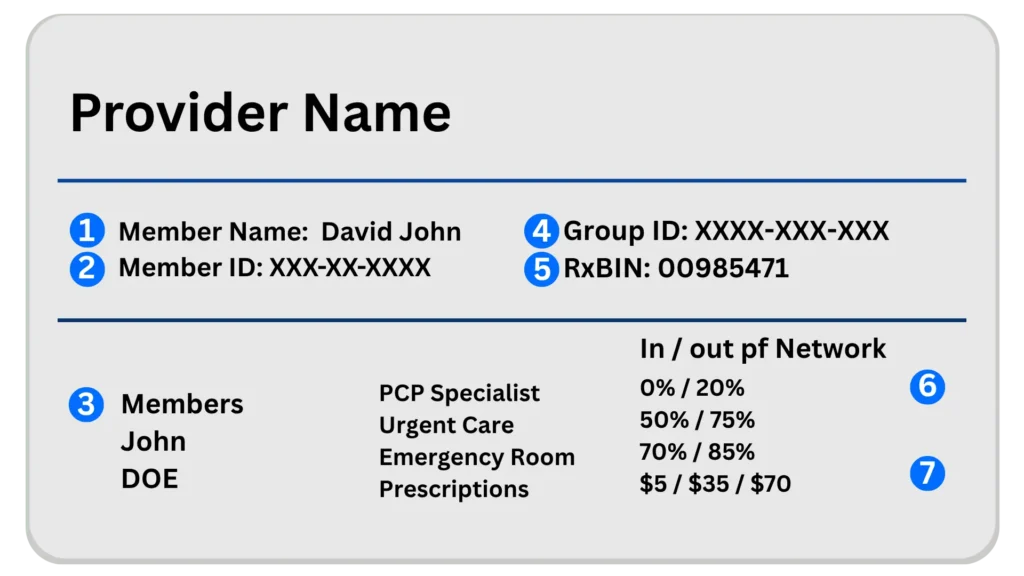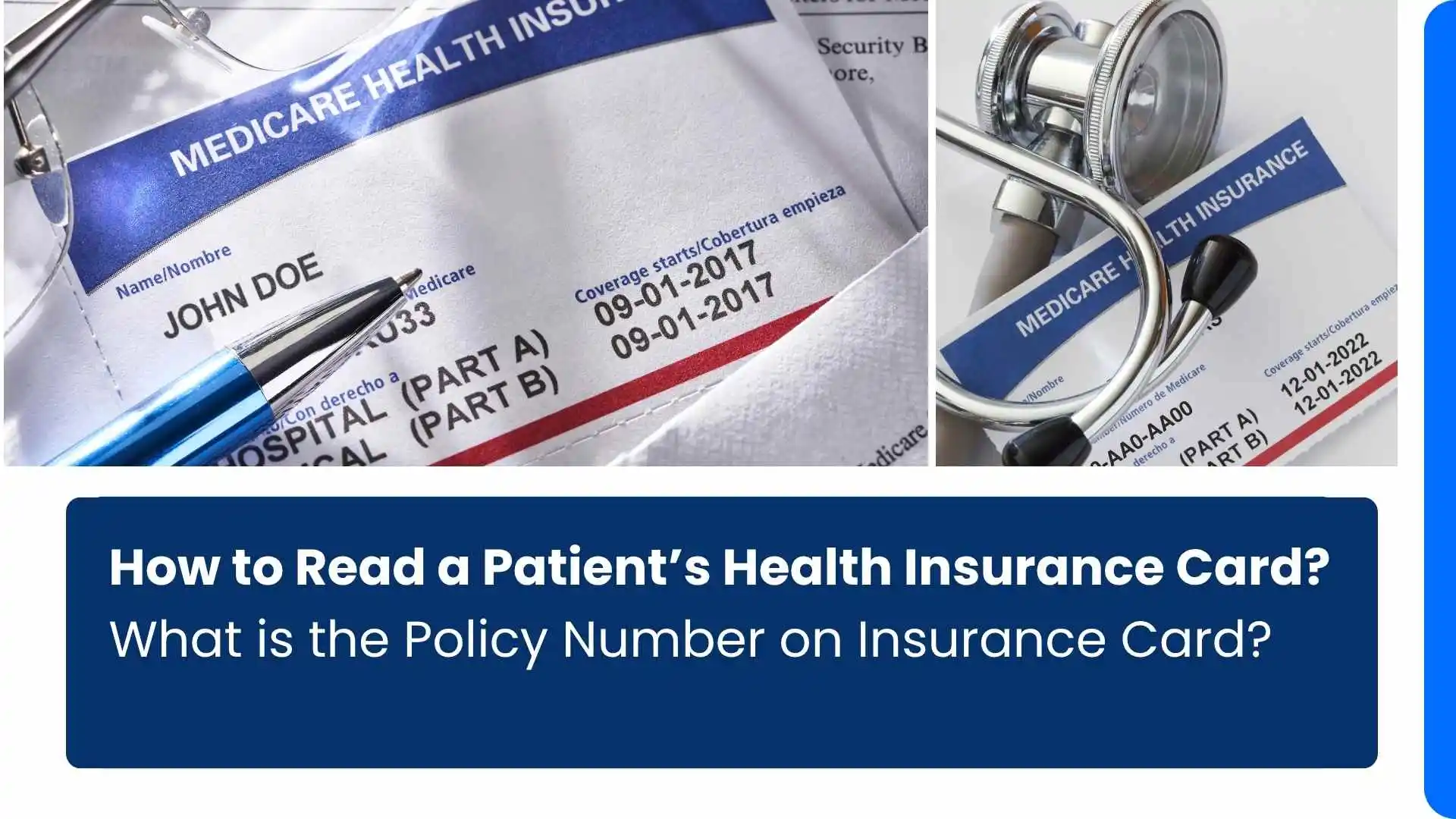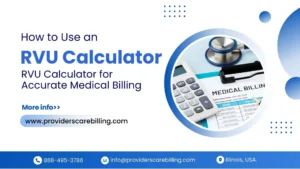Did you Know…90% of Americans have Health Insurance?
But do they know…what is the policy number on Insurance card? That’s something I doubt!
But why does it matter? Is it that Important?
The Answer is Yes…How? Well, this is something that we’re gonna discuss later in this blog. These insurance cards and Policy codes are not just a bunch of numbers that you have to remember – It is your key to processing claims faster, verifying insurance coverage and much more. We’ll also tell you how to read health insurance cards and help you understand different complex terms like PCN, RXGRP, and member ID.
Why Your Insurance Card Is More Important Than You Think
Your insurance card is not just a simple plastic card. It allows you to get medical attention without the extra effort. All the information on the card is important, but the policy number is the most crucial one.
Let’s look at how being familiar with your card can help you.
- It makes easy to file claims without a snag.
- You can easily see what is covered by your insurance.
- You can keep your expenses under control.
Where to Find a Policy Number on Insurance Card?
Let’s get started…Can’t find the policy code on your insurance card. Just read out the instructions we mentioned below…
Usually, the policy number can be found at:
- The Front of the Card: Near the top, often labeled as “Policy Number” or “ID Number.”
- Next to Member ID: Sometimes set beside or below the member ID.
- Back of the Card: Some providers mention it on the back side of the card, especially for specialized plans.
What is a Policy Number for Medical Insurance?
A Policy Number is a unique identifier on your insurance plan. Consider it as your insurance account number that the provider uses to track your coverage and process claims. How long is an Insurance policy number? An insurance policy code is usually 9-13 digits long (but the exact length depends on your insurance provider). It is a combination of both letters and numbers, which makes it unique everytime.
How it differs from other numbers:
- Member ID: This is the ID used to identify you…the person itself, not the plan
- Group Number: It is found on employer-funded plans. This number links your policy to a specific company.
Understanding these two terms will help you read your insurance card better…
Understanding Other Key Terms on an Insurance Card
Your insurance card has a bunch of numbers and codes on it other than the policy number. Here’s what they mean and where to find them…
1. RXGRP:
The RXGRP (Prescription Group) number helps pharmacies identify your specific prescription plan within your insurance coverage. It’s typically located near the RXBIN and PCN numbers and is essential for processing medication claims.
2. PCN:
What is PCN on insurance card? The PCN (Processor Control Number) is a secondary identifier used alongside the RXBIN to route prescription claims to the correct provider.
- RX PCN Meaning: This code helps pharmacies determine how to handle prescription claims and which plan to bill.
3. Member ID vs. Policy Number:
- Member ID: Identifies you as the insured individual and is specific to you.
- Policy Number: Identifies the overall insurance plan or contract. While multiple members can share the same policy number, each member will have a unique ID.
Insurance Card Example – Decoding the Details
So, now that we have discussed all the terms…Let’s see what’s the policy number on an insurance card and how to read health insurance cards with this visual insurance card example.
Visual Breakdown:
Below is a visual guide to a standard insurance card, showing where to find:
- Policy Number: Near the top or alongside the member ID.
- RXGRP: Typically located next to the RXBIN, indicating your prescription group.
- PCN: Found near the RXBIN, used for routing prescription claims

Quick Reference:
- Policy Number: Your insurance plan’s unique identifier.
- Member ID: Your personal identification within the plan.
- Group Number: Identifies employer or group-sponsored plans.
- RXGRP: Prescription group number for medication claims.
- PCN: Processor Control Number for routing prescription claims.
This breakdown simplifies how to read health insurance cards so you can quickly locate the essential information without the guesswork.
What to Do if You Can’t Find the Policy Number:
If you have followed all these steps but still can’t find the policy code…Then here’s what you should do
1. Check Your Policy Documents:
Your insurance policy documents often include the policy number along with other essential details. Look for sections labeled “Policy Information” or “Coverage Details.”
2. Contact Customer Support:
If you still don’t know what is the policy number on an insurance card, then reach out to your insurance provider. They will use your member ID or Group number to verify your policy code.
3. Access Digital Insurance Cards:
In recent times, many insurance companies have provided digital insurance cards to their customers through their apps and websites. Log in to your account and check for a digital version of your card, which will clearly display your policy code.
Common Questions About Insurance Card Details:
1. What is RXGRP on an Insurance Card?
The RXGRP (Prescription Group) number helps pharmacies identify the specific prescription plan linked to your insurance. It’s particularly important when processing medication claims and is usually located next to the RXBIN and PCN numbers.
2. How is the PCN Used for Prescription Claims?
The PCN (Processor Control Number) directs prescription claims to the correct insurer or pharmacy benefit manager. It works alongside the RXBIN to route the claim to the appropriate provider and ensure accurate processing.
3. What is a Group Number on a Health Insurance Card?
A group number is your policy by a particular employer, organization or insurance plan. It is usually next to the policy code and assists the provider in figuring out which plan you are covered under.
Related: For instance, if you’re visiting a doctor for persistent symptoms like fatigue, your provider may use a diagnosis code like ICD-10 R53.83 for Fatigue. Having your insurance policy number handy ensures the claim is filed correctly and tied to the appropriate diagnosis—saving you from future billing confusion.
Conclusion:
So, learning about what is the policy number on insurance card is more than just studying a series of numbers. It is your insurance code and is necessary to file claims and validate your coverage. The situation won’t matter, and if you know all these things…you’re safe from a lot of hassle.
For most cases, the policy number will be at the top of the card beside the member ID or at the back for specialty plans. Also note the other important identifiers like RXGRP, PCN and group number, all of which play a role in managing your policy.
If you’re still uncertain about any details, reach out to customer service, review your insurance documents, or check the digital version of your card.




